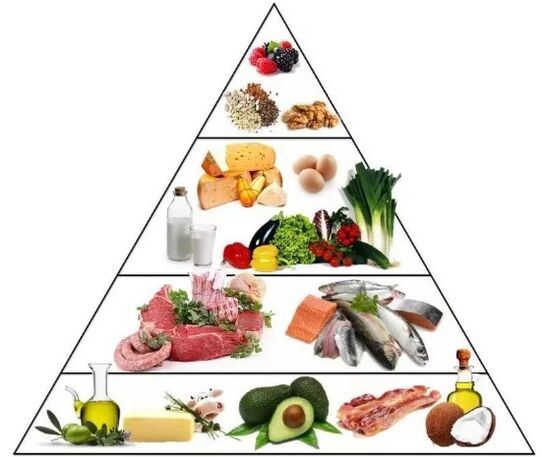Strictly speaking, only the one that causes an increase in the level of ketone bodies of blood can be called a ketogenic diet.
But since this level is extremely rarely controlled by research participants and simply adherents of this type of nutrition, in this article, the keto-diet will be called all power options with the amount of carbohydrates less than 10% of daily calorie content. Here we also assigned Low-Carb-Princeps a diet, which is often distinguished as a separate type of nutrition.

Most sources of the calorie border for these two types of diet are the following:
- Keto-diet-up to 5% carbohydrates per day
- Low-Carb-Princeps diet-5-10%.
Physiology
Without it, there is no way here. So, with a different diverse diet with carbohydrates, covering up to 60% of the daily energy need, the body receives almost all energy from glucose - the final product of carbohydrate splitting.
Energy systems of cells of all organs are adapted to work on Glucosum fuel. Energy from it easily and quickly becomes affordable cells. Glucose penetrates through all the natural barriers of the body (for example, there are such in the brain), and some organs can only receive energy from it - for example, liver and blood red blood cells.
But what if the level of glucose in the blood falls - for example, you have not eaten for a long time? Or did the owner of this blood go to Keto diet? Then the same fat enters the stage. It breaks down to ketone bodies (from where and the name of the diet)-short fragments of fatty molecules, which include beta-oxyxylic acid, acetouxytic acid and acetone. As you can see, two of three ketone bodies - acids. Remember for the future.
Further, ketone bodies are distributed throughout the body, thanks to their small size, they penetrate well through barriers in the vessels of organs, absorbed by cells (except for liver cells, they do not know how to) and give even more energy per unit mass than glucose.
What is the catch?
First: ketone bodies - acids. And an increase in their concentration in the blood shifts its acid-base balance.
Yes, in healthy adults, blood pH will not change to critical indicators. And in children or, for example, diabetics, this is a fairly frequent phenomenon.
Maybe you heard about "increased acetone" in young children? Which, to return to the normal state, you need to drip glucose or, if the condition allows you to steal a sweet compote on a teaspoon (because any large volumes cause vomiting) for several days? ThisKetoacidosis- increased content of ketone bodies with blood oxidation, which we are trying to artificially call with a diet.

Second: obtaining energy from ketone bodies in chemically is completely different compared to glucose. With normal nutrition, this path is rarely involved, the necessary enzymes are few.
Therefore, the transition between ordinary and keto-diet can be heavy. But-and this attracts athletes-Keto-diet trains the path of energy from fats, and subsequently the body is easier to rebuild.
Ketogenic diet and excess weight
Everything here looks very optimistic. In this study, for a year on Keto-Dita, people with obesity dropped 19. 9 kg, and people with the same obesity, but simply reduced calories-7 kg. Moreover, the weight after switching with Keto back to ordinary power continued to decline.
In a similar study, which lasted two years, on Keto-Dita, the participants dropped 12. 5 kg mainly due to fat, their waist volume decreased, and during the same time, people lost only 4. 4 kg on a normal diet.
On Keto-Dita, combined with training, the participants lost weight due to fat. During the same time, the control group with regular nutrition and the same training gained weight. The calorie content of the diet in both groups was not limited.
A review of publications on the effectiveness of a ketogenic diet in obesity confirms its effectiveness and makes several important warnings:
- Be sure to control the work of the kidneys;
- The neat, gradual transition to keto-diet and back to traditional nutrition is important;
- The duration can vary from two weeks to a year or more (usually a rigid restriction of carbohydrate receipt - less than 5% of the day caloring - is prescribed for a limited period, softer options - for several months or more);
- Keto diet is the treatment of obesity and the attitude to it should be as any other medicine, with the control of the state and the supervision of a doctor.
Keto diet and sports results
Based on the features of glucose metabolism and ketone bodies, it can be assumed that a traditional diet with a large amount of carbohydrates better provides the body's needs during short high -intensity loads.
And Keto-diet trains the ability to receive energy from fat, improving tolerance and results in long loads of low intensity. Well, at the same time, kilograms are clearly facilitated by kilograms. Studies partially confirm this.
For example, in a group of athletes engaged in sports walking, after three weeks of the keto-diet, VO2MAX increased, but the results worsened, since more oxygen is needed to oxidize ketone bodies. In a group on a diet with periodically or constantly accessible carbohydrates with the same training, the results improved.

As we expected, even the short-term (4 days) Keto diet worsens the results in anaerobic high-intensity exercises.
After 12 weeks, athletes involved in endurance athletes, the mass of 5. 9 kg decreased, the amount of subcutaneous fat decreased, the level of ketone bodies increased 5 times, but the results in stiffening training (compared with the control group that received the usual amount of carbohydrates) did not change. Perhaps due to the fact that during test exercises a group on keto-red dried water with electrolytes, and a control group-carbohydrate drinks.
The combination of powerlifting and keto-diets helps to effectively remove fat while maintaining sports indicators (research), and is logical not suitable for recruiting muscle mass.
Total:
- Keto diet increases VO2 Max, it is great for the training season with endurance focus when long-term low-intensity training prevail.
- Large training volumes in combination with a keto-diet reduce the amount of fat, weight and muscle damage after loads (since lactate does not form from ketone bodies).
- On the other hand, a decrease in glycogen reserves and the low activity of the enzymes splitting it worsen the results of speed work.
Ketogenic diet and various diseases
When the keto-diet only appeared (and it was 1920, then people did not suffer at obesity, they rejoiced at him), it gained popularity as an effective means of alleviating the state in epilepsy. Now it is also used as additional treatment of drugs of epilepsy cases that are difficult to drug therapy, although it works at the molecular level - it remains not completely understandable.
In patients with diabetes of the second type (not dependent on insulin), the keto diet turned out to be effective (better than the usual low-calorie diet) and a fairly safe way to reduce weight and control the level of glucose of blood.
Keto diet also helps with polycystic ovary syndrome, reducing both psychological and physiological symptoms.
Side effects
Keto diet is not the most physiological diet, it very much modifies the metabolism, forcing it to work in the "reserve" mode, which, with ordinary nutrition, is extremely rare.

Therefore, different unpleasant sensations, especially when switching to a keto diet and vice versa, are often found. The most common are headache, nausea, vomiting, stool disorders, back pain.
Mineral and fat metabolism, the formation of kidney stones, metabolic acidosis (a change in blood pH in the acidic side) are less commonly possible. In children and people with impaired sensitivity to insulin, acidosis can reach critical meanings, leading to a coma.
To prevent these side effects, during keto-diets, you need to take vitamins, minerals, protein, drink a lot of water and there are many vegetables. It is possible to include drugs in the diet.
Who is contraindicated in Keto-diet
First of all, people with congenital fat metabolism disorders. If you have this, most likely you know about it. But to check it will not hurt.
Keto-diet is also prohibited to people with porphyria and a pyrowat-carboxylase deficiency (sorry for such words here, but, again, if a person has any of these diagnoses-he will see him and will not risk health on a keto-diet).
For people with diabetes of the second type, taking sodium-glucose coter type 2 type 2. They should change treatment or also avoid a keto-diet.
Total: what, to whom and how to eat and whether you need it at all
Keto diet is really more effective than a simple calorie restriction helps to reduce the weight of fat in the body without muscle loss. It also helps with some endocrine pathologies.
Low-Carb Power stimulates the path to getting energy from fats, so that the body is easier to rebuild on this version of metabolism with prolonged low-intensity loads. The results do not change, and sometimes even worsen. In sprint, they always worsen. Keto diet should be practiced in the middle of the training season, when important starts are far away, the volumes are large, and the speeds are low.

Before changing the type of power, you need to make sure that you have everything in order with the exchange of fats. The entrance to the diet and exit from it should be gradual, with careful monitoring of well -being. During a diet, it is important to drink a lot of water, there are vegetables, take vitamins and trace elements.
It is better to treat keto-diet not as a diet, but as a medical event that requires a constant laboratory and preferably medical control.
As a safer option with close results, we offer Low-Carb-Princeps a diet (in which approximately 10% of the daily diet is carbohydrates) with periodic inclusion in the diet of useful carbohydrate products such as whole grains. She has less side effects, and the results are close.
And as an experiment, try to remove fast carbohydrates from the diet. There is a lot of harm from them, there is no benefit (except for the joy of the tasty cake eaten), the weight will decrease, at the same time you will find out what it is with the restriction of carbohydrates - a successful experiment from all sides!
Run a lot, eat tasty and be healthy!






























